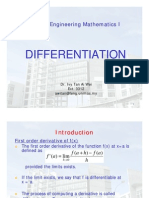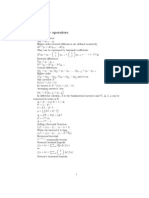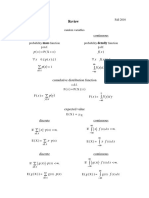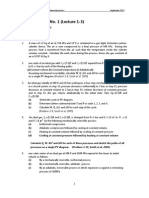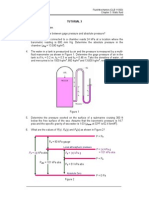hw3 Soln
hw3 Soln
Uploaded by
Ilham SaputraCopyright:
Available Formats
hw3 Soln
hw3 Soln
Uploaded by
Ilham SaputraOriginal Title
Copyright
Available Formats
Share this document
Did you find this document useful?
Is this content inappropriate?
Copyright:
Available Formats
hw3 Soln
hw3 Soln
Uploaded by
Ilham SaputraCopyright:
Available Formats
Math 285 Homework # 3
Due Friday Sept. 5 in class.
Section 1.4 # 3,14,17,36
Section 1.5 # 4,8,15,16,23,42
Section 1.6 # 16,35,59
1.4.3
dy
dx
= y sin(x)
_
dy
y
=
_
sin(x)dx
ln |y| = cos(x) + c
y = Ae
cos(x)
1.4.14
dy
dx
=
1 +
x
1 +
y
_
(1 +
y)dy =
_
(1 +
x)dx
y +
2
3
y
3
2
= x +
2
3
x
3
2
+ c
1.4.17
dy
dx
= 1 + x + y + xy
= (1 + x)(1 + y)dx
_
dy
1 + y
=
_
(1 + x)dx
ln |1 + y| = x +
x
2
2
+ c
y = c exp(x +
x
2
2
) 1
1.4.36
N(t) = N(0) exp(kt)
1
2
From the text N(0) = 5 10
10
, N(t) = 4.6 10
10
, k = .0001216.
Solving for t gives
t =
ln(4.6/5.0)
.0001216
686
Your conclusions here.....
1.5.4
y
2xy = exp(x
2
)
y
exp(x
2
) 2xy exp(x
2
) = 1
d
dx
(y exp(x
2
)) = 1
(y exp(x
2
) = x + c
y = xexp(x
2
) + c exp(x
2
)
1.5.8
3xy
+ y = 12x
y
+
1
3x
y = 4
y
x
1
3
+
1
3
yx
2
3
= 4
d
dx
(yx
1
3
) = 4
(yx
1
3
) = 4x + c
y = 4x
2
3
+ cx
1
3
1.5.16
y
= (1 y) cos(x) y() = 2
ln |1 y| = sin(x) + c c = ln|1| = 0
y = 1 + exp(cos(x))
1.5.23
xy
+ (2x 3)y = 4x
4
y
+ (2
3
x
)y = 4x
3
The integrating factor is given by
(x) = e
R
(2
3
x
)dx
= e
2x3 ln(x)
=
e
2x
x
3
3
this gives
e
2x
x
3
y
+
e
2x
x
3
(2
3
x
)y = 4x
3
e
2x
x
3
d
dx
_
y
e
2x
x
3
_
= 4e
2x
y
e
2x
x
3
= 2e
2x
+ c
y = 2x
3
+ cx
3
e
2x
1.5.42 Using the fact that the volume is v =
4
3
r
3
one nds that the
mass of the hailstone is given by
m(t) =
4
3
k
3
t
3
Plugging this into Newtons law in the form
d
dt
(m(t)v) = m(t)g
gives
d
dt
_
t
3
v
_
= t
3
g
Integrating this up and plugging in v(0) = 0 gives
t
3
v =
t
4
4
g + c =
t
4
4
g
knowing that a particle falling under gravity usually satises v = gt
we can conclude that the hailstone accelerates as if gravity were
1
4
as
strong.
1.6.16
y
=
_
x + y + 1
Making the substitution w
2
= x + y + 1 and thus 2ww
= 1 + y
gives
2ww
1 = w
_
2wdw
1 + w
= dx
2w 2 ln(1 + w) = x + c
2
_
x + y + 1 2 ln(1 +
_
x + y + 1) = x + c
4
1.6.35
(x
3
+
y
x
)
. .
Q(y,x)
dx + (y
2
+ ln(x))
. .
P(y,x)
dy
Wed like to check if this is exact: if there is F(x, y) such that
F
x
=
Q(x, y) and
F
y
= P(x, y). A necessary and sucient condition is the
equality of the mixed partials. Computing we nd that
P
x
=
1
x
=
Q
y
and thus there is such a function F. In order to nd it we integrate
one of the equations
F
y
= (y
2
+ ln(x))
F =
y
3
3
+ y ln(x) + C(x)
F
x
=
y
x
+ C
(x) = x
3
+
y
x
C(x) =
x
4
4
Thus the solution is given by
F(x, y) =
y
3
3
+ y ln(x) +
x
4
4
= constant
which denes y implicitly as a function of x. One cannot explicitly
solve for y as a function of x.
1.6.59 The easiest way to solve
dy
dx
=
x y 1
x + y + 3
is to multiply through by x + y + 3 to get
(x + y + 3)
. .
P(x,y)
dy + (1 + y x)
. .
Q(x,y)
dx = 0
It is easy to see that this is exact:
Q
y
= 1 =
P
x
5
The we solve
F
y
= (x + y + 3)
F = xy +
y
2
2
+ 3y + C(x)
F
x
= y + C
(x) = 1 + y x
C
(x) = 1 x
C(x) = x
x
2
2
Thus the solution is
F(x, y) = xy +
y
2
2
+ 3y + x
x
2
2
= constant
You might also like
- 7890 Service ManualDocument744 pages7890 Service Manualremco rosema80% (15)
- Complete Kia Cadenza Automatic Transmission Repair ManualDocument38 pagesComplete Kia Cadenza Automatic Transmission Repair Manualявор виткин0% (1)
- MTH101 Practice Qs Solutions Lectures 23 To 45Document27 pagesMTH101 Practice Qs Solutions Lectures 23 To 45Abdul Rafay86% (7)
- Constant RuleDocument6 pagesConstant Ruledave garazaNo ratings yet
- Alfa Laval MFPX 307tfd-21Document218 pagesAlfa Laval MFPX 307tfd-21hdabc12375% (4)
- D.E 3rd EditionDocument33 pagesD.E 3rd Editionken100% (2)
- Literature Review PDFDocument12 pagesLiterature Review PDFpoudelNo ratings yet
- Hyster W65Z (A229) W60Z (A231) W80Z (A234) Walkie Forklift Parts ManualDocument8 pagesHyster W65Z (A229) W60Z (A231) W80Z (A234) Walkie Forklift Parts ManualManuals CE & AgNo ratings yet
- MMAN2700 Laboratory T1 2014Document4 pagesMMAN2700 Laboratory T1 2014Abhishek SharanNo ratings yet
- MAT2384 Assignment #1: Dy Dy DX X Dy DX XDocument6 pagesMAT2384 Assignment #1: Dy Dy DX X Dy DX XKhoi Phan FofNo ratings yet
- CQF January 2014 Maths Primer Exercises and SolutionsDocument16 pagesCQF January 2014 Maths Primer Exercises and SolutionsladykryaNo ratings yet
- 2233 mt1 S99sDocument5 pages2233 mt1 S99sAkoh C Josh ÜNo ratings yet
- Knf1013 Week9 Differentiation Compatibility ModeDocument37 pagesKnf1013 Week9 Differentiation Compatibility ModeSyura PisyuNo ratings yet
- Differential EqutionDocument4 pagesDifferential EqutionthinkiitNo ratings yet
- Detailed Solutions A-07 JUNE 2003: I X X F F IDocument32 pagesDetailed Solutions A-07 JUNE 2003: I X X F F IAdzLinkBalaoangNo ratings yet
- Solutions To Exercises in Functions of More Than One Variable - Partial Differentiation Exercises On 16.1Document21 pagesSolutions To Exercises in Functions of More Than One Variable - Partial Differentiation Exercises On 16.1Carlos BohorquezNo ratings yet
- Chain Rule ReverseDocument11 pagesChain Rule ReverseJosué QuintanillaNo ratings yet
- Predictor Corrector MethodDocument5 pagesPredictor Corrector Methodlazarbaruch3033No ratings yet
- Calculus: Differentiation RulesDocument17 pagesCalculus: Differentiation RulesAoSd' TikmanNo ratings yet
- Review1 PDFDocument22 pagesReview1 PDFdNo ratings yet
- © Praadis Education Do Not Copy: Exercise 2.4Document10 pages© Praadis Education Do Not Copy: Exercise 2.4A MANIMARAN manimaran.shNo ratings yet
- 30 Diffrentiation Part 1 of 1dddddddddddddDocument18 pages30 Diffrentiation Part 1 of 1dddddddddddddVishal VjNo ratings yet
- IntegralsDocument27 pagesIntegralssudersanaviswanathanNo ratings yet
- Differential EquationDocument28 pagesDifferential Equationronhuman14No ratings yet
- Ncert Solutions For Class 9 Maths April05 Chapter 2 Polynomials Exercise 2 4Document8 pagesNcert Solutions For Class 9 Maths April05 Chapter 2 Polynomials Exercise 2 4chaitanyaapande24No ratings yet
- Exact Equations (Section 1.4) : Solutions For Selected ProblemsDocument6 pagesExact Equations (Section 1.4) : Solutions For Selected ProblemsTumi MothusiNo ratings yet
- AY14-15 Sem2 M63 LE5 AnsDocument5 pagesAY14-15 Sem2 M63 LE5 AnsNo OneNo ratings yet
- Leep 207Document27 pagesLeep 207Koyal GuptaNo ratings yet
- NCERT Solutions For Class 9 Maths Chapter 2 Polynomials Ex 2.1Document20 pagesNCERT Solutions For Class 9 Maths Chapter 2 Polynomials Ex 2.1anilNo ratings yet
- X Summation X N Upper, I Starting Point X Format PormaDocument2 pagesX Summation X N Upper, I Starting Point X Format PormaMiko ArniñoNo ratings yet
- SummationDocument2 pagesSummationLeilalyn NicolasNo ratings yet
- SmallBook-maths Formula SheetDocument2 pagesSmallBook-maths Formula Sheetankur_1231No ratings yet
- 10 Maths Key Concept-2Document29 pages10 Maths Key Concept-2vishal_bokaroNo ratings yet
- Math 31 Chapter 10 and 11 LessonsDocument26 pagesMath 31 Chapter 10 and 11 LessonsSam PanickerNo ratings yet
- Xy Xy y X: Solve Cauchy-Euler Type Differential Equation - Solution: Method 1: (A) LetDocument5 pagesXy Xy y X: Solve Cauchy-Euler Type Differential Equation - Solution: Method 1: (A) Letmasyuki1979No ratings yet
- Interpolation and Approximation TheoryDocument15 pagesInterpolation and Approximation TheoryFaisal RahmanNo ratings yet
- Continuity and Differentiation: Points To RememberDocument8 pagesContinuity and Differentiation: Points To RememberAakash ChanNo ratings yet
- 101 - Full Derivative ReportDocument25 pages101 - Full Derivative ReportAmroKashtNo ratings yet
- Linear Differential EquationsDocument30 pagesLinear Differential Equationsshivam12365No ratings yet
- Linear Differential Equations MCQDocument5 pagesLinear Differential Equations MCQprakhar mishraNo ratings yet
- Tutorial 4 So LNDocument9 pagesTutorial 4 So LNBobNo ratings yet
- Quiz1 - Differential Equation - Jasmin - Cristine AngelDocument7 pagesQuiz1 - Differential Equation - Jasmin - Cristine Angelcristineangeljasmin04No ratings yet
- HW 2.5 Solutions PDFDocument7 pagesHW 2.5 Solutions PDFharshasg92No ratings yet
- CSM Chapters16 PDFDocument34 pagesCSM Chapters16 PDFJuan Sebastian TrujilloNo ratings yet
- Bernoulli SDocument5 pagesBernoulli SkennethNo ratings yet
- Problem Set 7 Solutions PDFDocument33 pagesProblem Set 7 Solutions PDFfrancis_tsk1No ratings yet
- Bernoulli Equation. Example 1, 2, 3Document4 pagesBernoulli Equation. Example 1, 2, 3harabassNo ratings yet
- Worksheet 4 .7 Polynomials: Section 1Document11 pagesWorksheet 4 .7 Polynomials: Section 1atiggy05No ratings yet
- Ncert Solutions Class 9 Math Chapter 2 Polynomials Ex 2 4Document11 pagesNcert Solutions Class 9 Math Chapter 2 Polynomials Ex 2 4Lochan. C.NNo ratings yet
- Indefinite IntegrationDocument24 pagesIndefinite IntegrationAditya BansalNo ratings yet
- Fall 2013 Math 647 Homework 5Document9 pagesFall 2013 Math 647 Homework 5gsmarasigan08No ratings yet
- Functions: If F (X) 2x - 2x + 1, Find F ( - 1) - (B) If F (T) 3t - 1, Find F (A)Document14 pagesFunctions: If F (X) 2x - 2x + 1, Find F ( - 1) - (B) If F (T) 3t - 1, Find F (A)Dinesh RajNo ratings yet
- D.E 6rd EditionDocument33 pagesD.E 6rd EditionkenNo ratings yet
- Term Paper of Mth102, Sec No-D6905, Roll No-A05Document13 pagesTerm Paper of Mth102, Sec No-D6905, Roll No-A05Kool KaishNo ratings yet
- THE CONSTANT MULTIPLE RULE. WordDocument13 pagesTHE CONSTANT MULTIPLE RULE. WordDina Grace MagnayeNo ratings yet
- maths c&d 2Document4 pagesmaths c&d 2Maithali SinghNo ratings yet
- 14 - FDWK C4 Ism 07Document33 pages14 - FDWK C4 Ism 07Andy GaoNo ratings yet
- Final Exam Solutions: Math 116: Finashin, Pamuk, Pierce, Solak June 7, 2011, 13:30-15:30 (120 Minutes)Document4 pagesFinal Exam Solutions: Math 116: Finashin, Pamuk, Pierce, Solak June 7, 2011, 13:30-15:30 (120 Minutes)Suresh kumarNo ratings yet
- 5 - IntegrationDocument9 pages5 - IntegrationSham JaggernauthNo ratings yet
- Tangent Line Ex 3.3Document13 pagesTangent Line Ex 3.3saaddaas0001No ratings yet
- HW 2 SolutionDocument7 pagesHW 2 SolutionAnonymous 9qJCv5mC0No ratings yet
- Mathematics 1St First Order Linear Differential Equations 2Nd Second Order Linear Differential Equations Laplace Fourier Bessel MathematicsFrom EverandMathematics 1St First Order Linear Differential Equations 2Nd Second Order Linear Differential Equations Laplace Fourier Bessel MathematicsNo ratings yet
- Analytic Geometry: Graphic Solutions Using Matlab LanguageFrom EverandAnalytic Geometry: Graphic Solutions Using Matlab LanguageNo ratings yet
- Factoring and Algebra - A Selection of Classic Mathematical Articles Containing Examples and Exercises on the Subject of Algebra (Mathematics Series)From EverandFactoring and Algebra - A Selection of Classic Mathematical Articles Containing Examples and Exercises on the Subject of Algebra (Mathematics Series)No ratings yet
- CSWIP Question AnswersDocument11 pagesCSWIP Question AnswersMuhammed Sulfeek100% (1)
- Induction Generator in Wind Power Systems: Yu ZouDocument44 pagesInduction Generator in Wind Power Systems: Yu ZouSherif M. DabourNo ratings yet
- Engineering (ENGIN) : CoursesDocument20 pagesEngineering (ENGIN) : CoursesSmith AlejosNo ratings yet
- Spare Parts List: 90031310 R902005415 Drawing: Serial NumberDocument28 pagesSpare Parts List: 90031310 R902005415 Drawing: Serial NumberAdrian MartinNo ratings yet
- 37 Leafs PriiDocument7 pages37 Leafs PriiqwureyquweryNo ratings yet
- 00 Hole CleaningDocument159 pages00 Hole CleaningMOH HAIDLER ALI SYAFIINo ratings yet
- Revamp Fired Heaters To Increase CapacityDocument8 pagesRevamp Fired Heaters To Increase Capacityyogitadoda100% (3)
- Free Piston Engine Working PDFDocument2 pagesFree Piston Engine Working PDFAmy0% (1)
- Installation & Maintenance Manual: Boiler Blowdown Control SystemDocument12 pagesInstallation & Maintenance Manual: Boiler Blowdown Control SystemperumalNo ratings yet
- Plate No. 6: Analysis of Indeterminate Frame Structure Using Moment Distribution MethodDocument5 pagesPlate No. 6: Analysis of Indeterminate Frame Structure Using Moment Distribution MethodEfraim PablacioNo ratings yet
- PSV Sizing Psv-402 Update PsetDocument7 pagesPSV Sizing Psv-402 Update PsetBui Khoi Nguyen100% (1)
- Handling, Moisture Management, and Storage of Biological ProductsDocument20 pagesHandling, Moisture Management, and Storage of Biological ProductsWan RadhiahNo ratings yet
- Reclaimer ChainDocument4 pagesReclaimer ChainAmeer Ahmad RazaNo ratings yet
- Procedure For CASED HOLE Sidetrack WhipstockingDocument12 pagesProcedure For CASED HOLE Sidetrack WhipstockingMohamed MahmoudNo ratings yet
- Mat FoundationDocument38 pagesMat FoundationLouisse May GeminaNo ratings yet
- 2 - Quiz - Free Fall ProjectileDocument2 pages2 - Quiz - Free Fall ProjectileMiya GomezNo ratings yet
- Lenntech: 18 Frame Block-Style Stainless Steel Plunger PumpDocument4 pagesLenntech: 18 Frame Block-Style Stainless Steel Plunger Pumpdiv02No ratings yet
- Senior Mechanical Manufacturing Engineer in Lebanon Hanover NH Resume Donald AveryDocument2 pagesSenior Mechanical Manufacturing Engineer in Lebanon Hanover NH Resume Donald AveryDonald AveryNo ratings yet
- 02-Engine Mechanical SystemDocument96 pages02-Engine Mechanical Systemsalvador341100% (1)
- HW10Document5 pagesHW10Harvin WaraichNo ratings yet
- Tutorial 1 (Lecture 1-3)Document2 pagesTutorial 1 (Lecture 1-3)eja70No ratings yet
- Tutorial 3Document3 pagesTutorial 3M Syafiq SamadNo ratings yet
- DSGDocument64 pagesDSGWiki Andy100% (2)
- Properties of Matter and Fluid MechanicsDocument7 pagesProperties of Matter and Fluid Mechanicsgokulkrishna2k7No ratings yet












